|
|||
|
Ever since The Walt Disney Family Museum opened in the Presidio of San Francisco on October 1, 2009, people have been telling me that I really must visit. And I would respond that San Francisco is a long way from the Chicago area where I live, but that the Museum was high on my list. Two weeks ago, I finally made it. Sam Gennawey’s presentation about Mineral King at the Museum and unusually low airfares were the two triggers that I needed. Now it’s my turn: You really must visit The Walt Disney Family Museum.
|
|||
|
|
|||
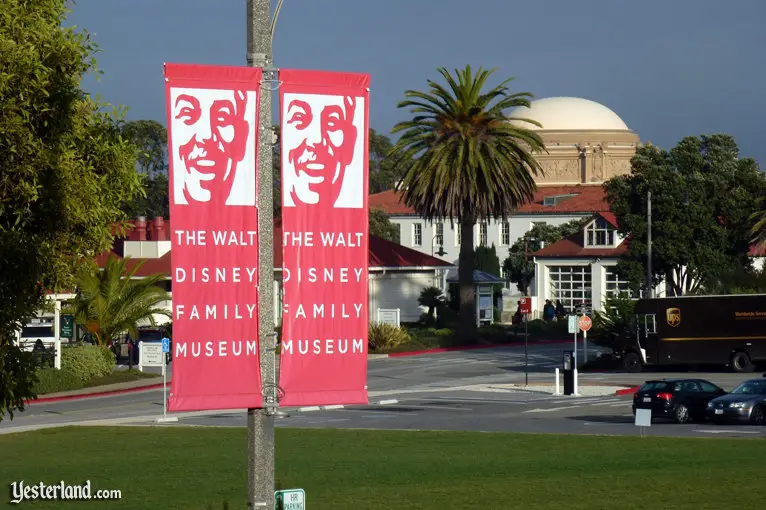
Photo by Werner Weiss, 2012 A view from the Museum porch, with the rotunda of the Palace of FIne Arts in the background |
|||
|
Let’s start with a basic question: Why does The Walt Disney Family Museum exist? After all, Walt Disney is possibly the best-known artist, innovator, and entrepreneur of the 20th century. The Walt Disney Company of today continues to run clips of its founder in everything from promotional videos to theme park attractions. His name and face are known to people of all ages, around the world. But what do people really know about Walt Disney? He left us in 1966. Two generations have been born since then. Although some people—especially people who read websites such as Yesterland—have read one or more of the biographies about Walt Disney, there are now far more people who know very little about the man and what he accomplished in his lifetime. |
|||
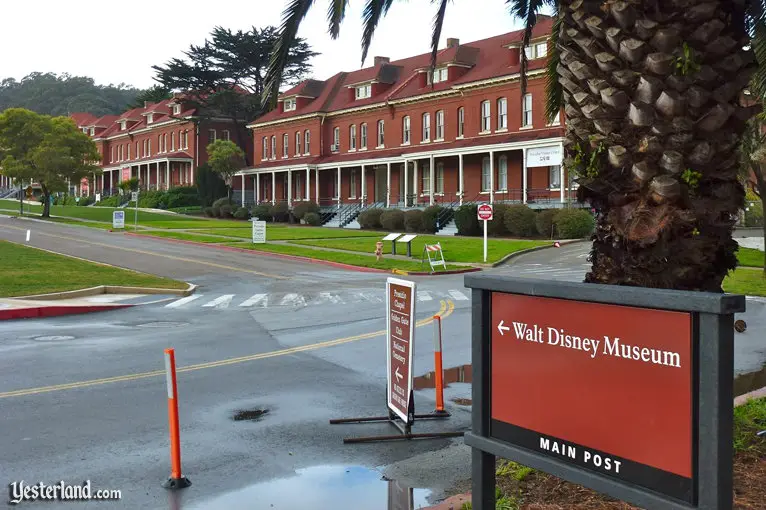
Photo by Werner Weiss, 2012 Museum (upper left) in one of the former Montgomery Street Barracks |
|||
|
Walt’s daughter, Diane Disney Miller, who co-founded the Museum, explains it well: “My father has one of the most well-known names around the world, but as the Disney ‘brand’ has grown, the man has become lost. We are committed to telling the story of Walt Disney’s life, in his own words, and in the words of others who knew him well and worked with him. My father was very open, and in the many conversations and interviews that you will hear in the galleries, you learn the story of his life. It is a wonderful story, and Dad himself loved to tell it. Thanks to the amazing work of many dedicated people, we are fortunate to be able to tell it here using the tools he worked with—art, music, film and technology—to present an honest yet affectionate portrait of this amazing artist and man.” This is not a museum about or by The Walt Disney Company. It’s a museum with a story that primarily takes place from 1901 to 1966. Of course the story includes Mickey Mouse, Snow White and the Seven Dwarfs, Disneyland, and Mary Poppins. But there’s far more to it than that. It’s about the real Walt Disney, his triumphs and disappointments. And the story is told very well. |
|||
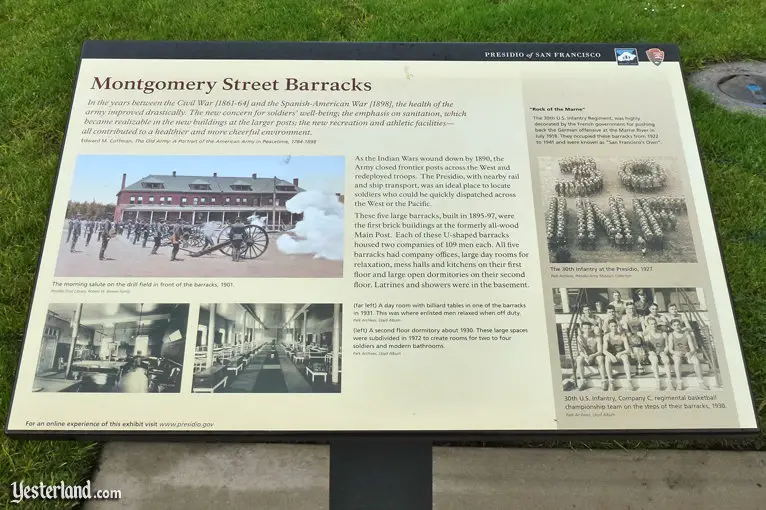
Photo by Werner Weiss, 2012 National Park Service history marker in the Presidio |
|||
|
The location of The Walt Disney Family Museum may seem a bit odd. Although San Francisco is a major city and gets many tourists, the Museum is located within the city’s historic Presidio—away from the hotels, attractions, and shopping of Union Square, Market Street, and Fisherman’s Wharf. The 1,491-acre Presidio had a history as an army post from 1776 until it was transferred to the National Park Service in 1994. Historic army buildings are being restored for public and private use, but the Presidio has not developed into a campus of museums and other visitor attractions. The late Donald Fisher, founder of Gap Inc., and his wife Doris had wanted to build a 100,000-square-foot museum at the Presidio to house their collection of 20th- and 21st-century art, but their plans were defeated by substantial opposition to such a prominent, new structure in a National Historic Landmark District. |
|||
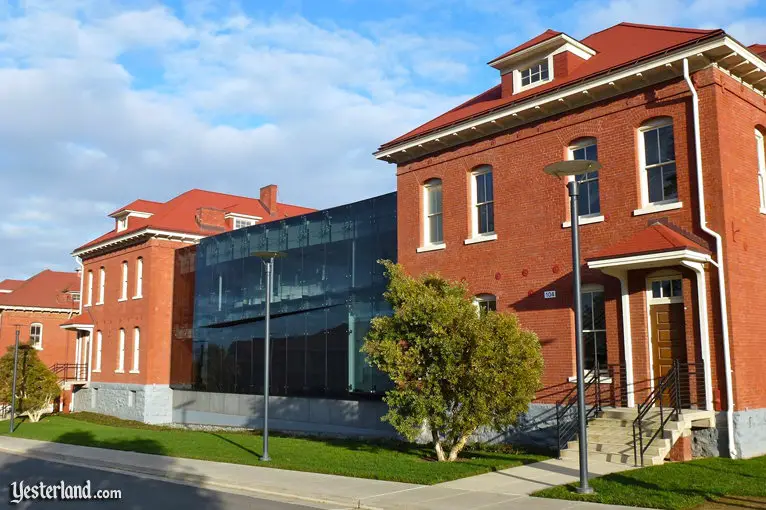
Photo by Werner Weiss, 2012 Rear of The Walt Disney Family Museum |
|||
|
The architects of The Walt Disney Family Museum skillfully restored and enlarged Building 104 of the Montgomery Street Barracks, originally built between 1895 and 1897. It’s one of five identical, side-by-side structures. The front of the building is a faithful historic restoration. Large banners serve as the sign. To gain more space, the architects filled in the courtyard of the U-shaped building. The addition is only visible from the back of the Museum. The glass wall of the addition provides a dramatic view of the Golden Gate Bridge from the gallery about Walt Disney’s True-Life Adventures. The Presidio is a lovely setting. With its hills, open spaces, greenery, and buildings from bygone eras, the Presidio has tranquility that’s missing from the busy, congested parts of San Francisco. People who make the effort to visit the Museum are rewarded not only by the Museum, but also by the Presidio. |
|||
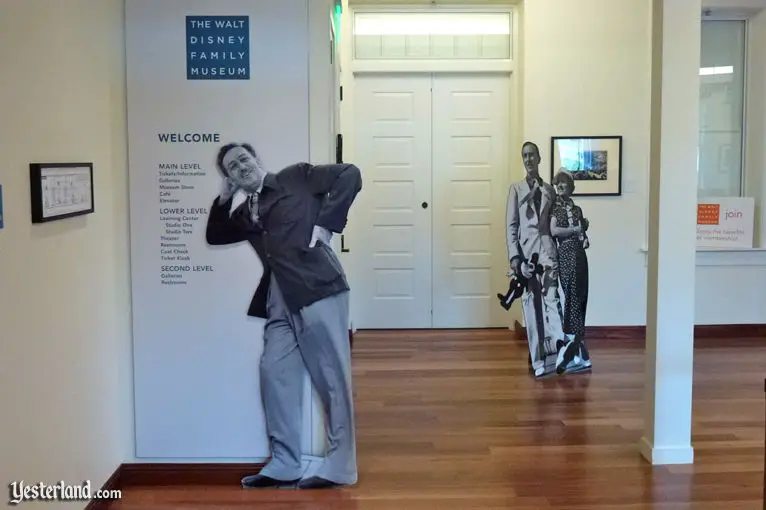
Photo by Werner Weiss, 2012 After entering through the front door |
|||
|
Now let’s go inside the Museum. The ticket counter is to your right. The lunch room and store are to your left. |
|||
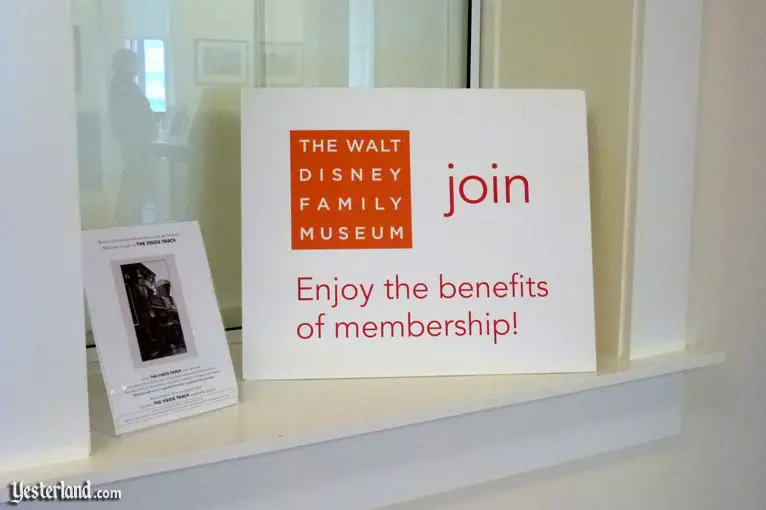
Photo by Werner Weiss, 2012 Memberships available |
|||
|
Knowing that I would be going to the Museum for several days, I decided to become a member at the $75 Individual level. Based on the current $20 daily admission ($15 for AAA members), I calculated that I would probably come close to breaking even, especially if I used the 10% discount in the Museum store and watched a screening of January’s movie, Third Man on the Mountain (1959), in the Museum’s theater ($7 for non-members, free for members). If I return in the next 12 months, I’ll come out ahead, especially if my wife joins me (as an Individual member, I can bring one guest). And it feels good being a member of such a fine museum. |
|||
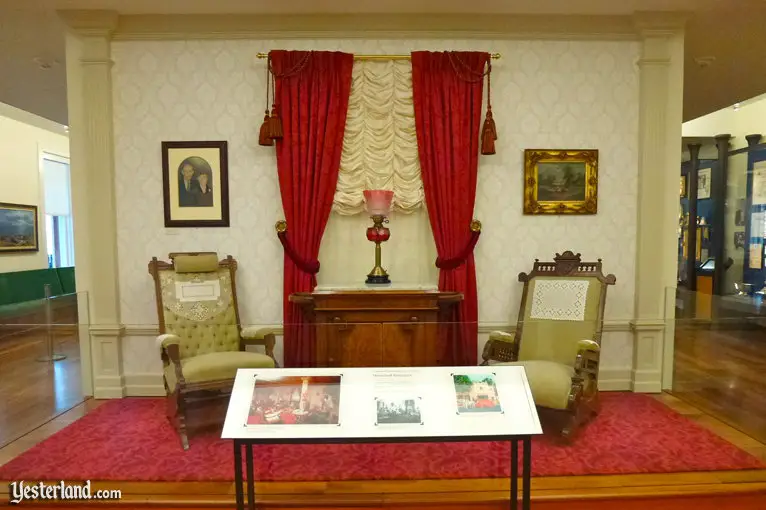
Photo by Werner Weiss, 2012 The actual furniture from Walt Disney’s apartment in the Disneyland fire station |
|||
|
At this point, you might be wondering if it’s really possible to spend multiple days at the Museum. The answer is yes. The Museum does many things well, and one of them is that it’s been designed so that visitors can enjoy it for a few hours or a few days. A typical visitor who might spend around three hours can pick up the high points of each gallery and have a great experience. But someone who wants to read the detailed captions, watch all the videos, listen to all the audio, and examine the artifacts closely can return day after day. Photography is not allowed in the Museum beyond the ticket lobby—not even in the lunch room or the Museum store. So the next few photos have been provided to me by The Walt Disney Family Museum. |
|||
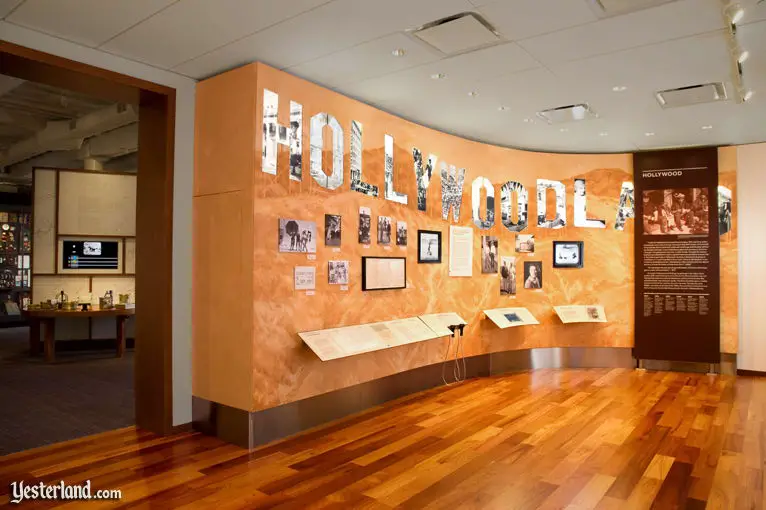
Photo by Jim Smith, Courtesy The Walt Disney Family Museum Walt Disney arrives in Hollywood in 1923. |
|||
|
Each gallery has it own look, influenced by the style of the decade. It’s not a case of theme park stage sets; it’s more subtle than that. For example, the ear pieces to listen to audio are based on how such technology looked at the time. The captions of the artifacts and images often use the words of Walt Disney, Roy Disney, family members, and those who worked with Walt instead of traditional museum captions. It makes the stories more personal, as well as lending authenticity to them. |
|||
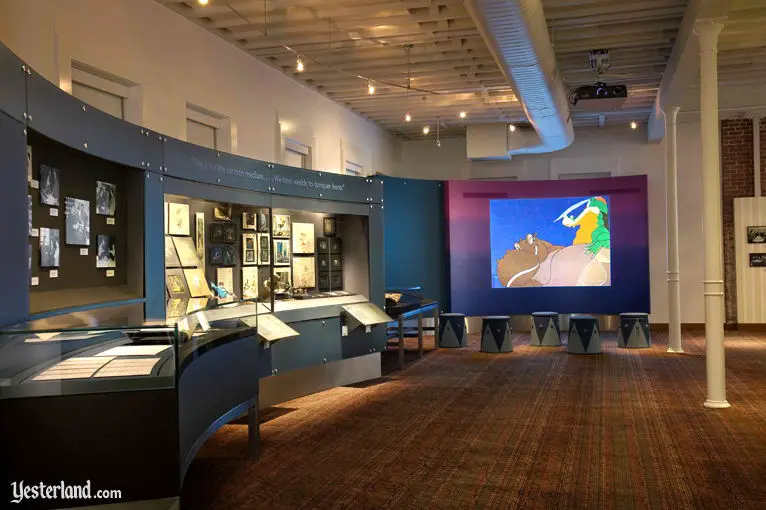
Photo by Jim Smith, Courtesy The Walt Disney Family Museum Making animated features, including Fantasia |
|||
|
Despite my enthusiasm for the Museum, there are a few things that I wish they had done differently (or that could be fixed). The Museum presents continuously repeating high-definition videos with audio, often narrated by Walt Disney. The problem is that a single gallery can have several videos, with their soundtracks not limited to right in front of the video. I’m not someone who thinks museums should be silent, but I found the noise in a few galleries with multiple soundtracks rather unpleasant—even to the degree that I had trouble reading captions with the distracting cacophony of voices competing for my attention. Although the Museum uses various techniques to tell its story, one thing it hasn’t done well is to include a series of small theaters with seats. You’ve probably been to museums that have them. There’s usually a sign telling you how many minutes until the next showing. It’s a great way to tell a short story from start to finish without distractions, while giving visitors a chance to get off their feet. And it keeps the audio inside the theater. |
|||
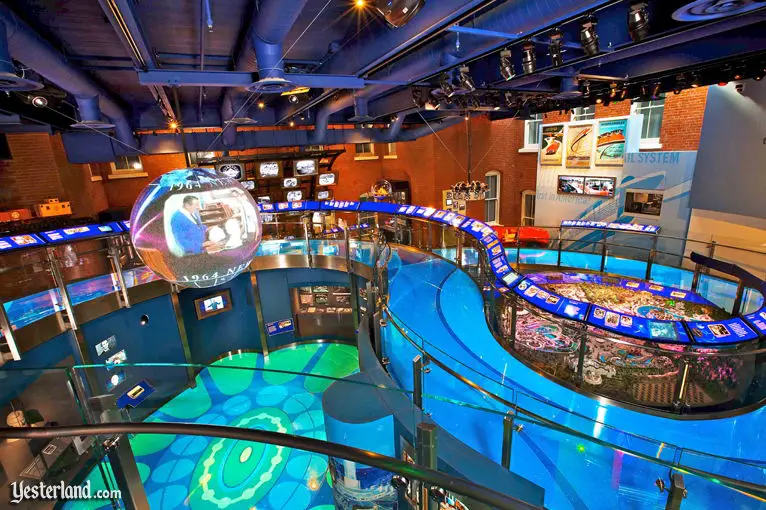
Photo by Jim Smith, Courtesy The Walt Disney Family Museum Overview of Gallery 9, featuring the 1950s and 1960s |
|||
|
As the Museum reaches the 1950s and 1960s, it uses the space that was added to the courtyard of the U-shaped building. This allows a dramatic two-story space. One of the artifacts here is the original Circarama camera, with 11 16mm cameras pointing in 11 directions to create a 360-degree movie. Another is the actual Lilly Belle train, which ran on a track around the Walt Disney family house in Holmby Hills. |
|||
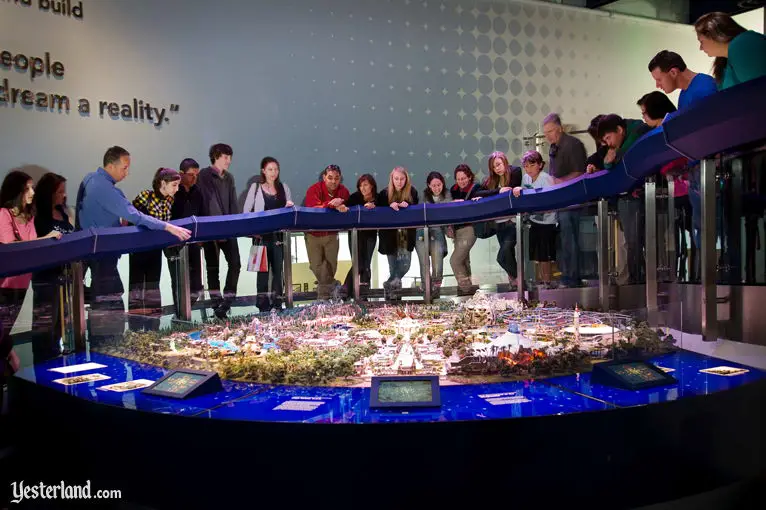
Photo by Jim Smith, Courtesy The Walt Disney Family Museum Guests admiring “The Disneyland of Walt’s Imagination” |
|||
|
My favorite feature of this gallery—perhaps of the whole Museum—is the large model of “The Disneyland of Walt’s Imagination.” A caption explains the premise, complete with a quotation from Walt: This elaborate Disneyland model does not document the park as it actually existed on opening day, nor any time afterward. Instead, it represents Walt’s ever changing vision of Disneyland as a dynamic location for fantasy, hope, and aspiration. “I’ll have a lot of things there eventually. You see these things I want to keep adding, keep plussing... Disneyland is a thing I can keep molding and shaping. It’s a three-dimensional thing to play with. But when I say play with it, I don’t mean that—everything I do, I keep a practical eye toward its appeal to the public, you see?” — WALT In this vision of Disneyland, earlier Tomorrowland attractions including the Flying Saucers, House of the Future, and the Rocket to the Moon coexist with later attractions such as the PeopleMover and Adventure Thru Inner Space, and even with an early concept for Space Mountain. The model is highly detailed. It’s a work of art. Actually, the entire Museum is a work of art. |
|||
|
|
|||
|
When I planned my trip to San Francisco, I became curious about whatever happened to a motel where I had stayed in the 1960s as child and then in the 1970s as a college student. It had been the Travelodge Presidio, located on a short, quiet segment of Lombard Street that continues in a straight line after the rest of Lombard Street (US-101) angles off as Richardson Avenue toward the Golden Gate Bridge. Surely it had been torn down decades ago, a victim of high real estate prices in San Francisco’s affluent Cow Hollow neighborhood. It turned out the building is still there. It’s still the Travelodge Presidio. And TripAdvisor ranked it at number 35 of 242 hotels in San Francisco—way ahead of the last two San Francisco hotels at which I had stayed (the Palace Hotel at number 69 and the Westin St. Francis at number 84). |
|||
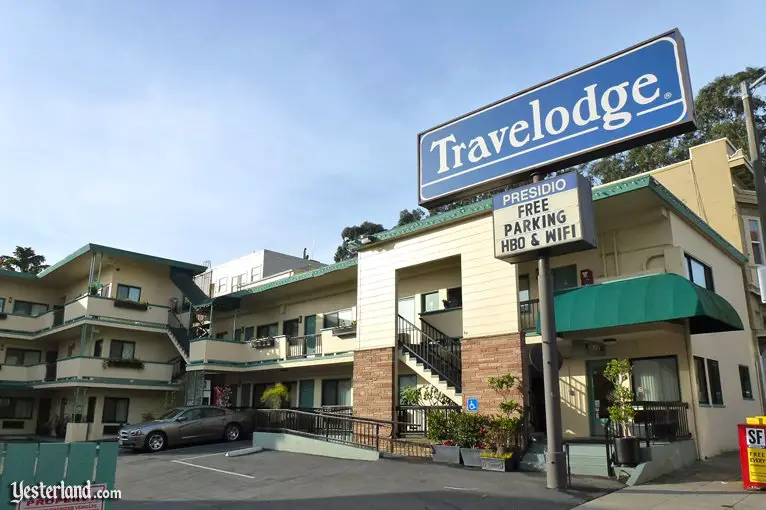
Photo by Werner Weiss, 2012 Travelodge Presidio in 2012 |
|||
|
I booked a seven-night stay at the Travelodge Presidio. The room rates were a fraction of the rates for hotels around San Francisco’s Union Square. Parking would be free. And, best of all, it would be a pleasant walk from the hotel to the Walt Disney Family Museum because the hotel is right at the Lombard Gate into the Presidio. However, I still had some concerns because the Travelodge chain suffers from a less-than-stellar reputation. I was quite happy with my stay at the Travelodge Presidio and would gladly stay there again. Of course, it’s in a different class from San Francisco’s grande dame hotels, and the TripAdvisor ranking doesn’t mean it’s a better hotel overall than the Fairmont (number 41). There’s a little motel office, not a magnificent lobby. My bathroom had a tiny shower stall. There is no elevator. The continental breakfast is basic, but included in the rate. The parking lot is tight, with fewer spaces than rooms, but I always found a space. This isn’t one of those cool, restored motels with decor reminiscent of the 1950s. It’s just a well-run, updated Travelodge. My room was clean and everything worked. In fact, the furniture in my room was less than two weeks old. The bed was comfortable and I slept well. I can’t say enough nice things about the staff—Tyler, Nicollete, Bruce, and Raymond—who seem to genuinely enjoy helping guests with dining, transportation, and attraction questions. Speaking of dining, I walked to good neighborhood restaurants on Lombard Street, Chestnut Street, and in the Presidio. |
|||
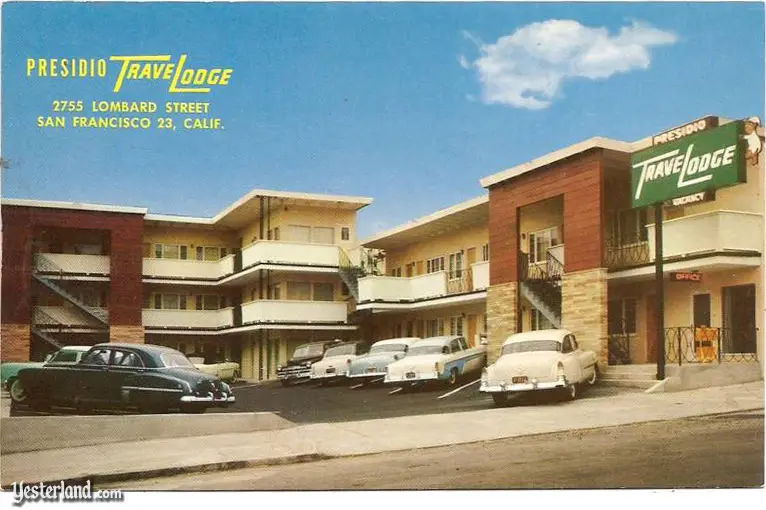
Historical postcard, Courtesy Tyler Shanahan, General Manager, Travelodge San Francisco Presidio Travelodge Presidio in the 1950s |
|||
|
I learned the Travelodge Presidio has been owned by the same family since it opened on April 18, 1955—exactly three months before the public grand opening of Disneyland. If you’re planning a trip to San Francisco to see The Walt Disney Family Museum, you might also want to consider staying on Lombard Street, especially if you’ll have a car. There are still a surprising number of motor hotels from the 1950s and 1960s on Lombard Street. I can’t speak from experience about any of the others. The Travelodge Presidio is a hotel that could give the Travelodge chain a good name. |
|||
|
|
© 2012 Werner Weiss — Disclaimers, Copyright, and Trademarks Updated August 10, 2012. Disclosure per FTC guidelines: Werner Weiss received a printed copy of the book Walt and the Promise of Progress City and a guest ticket to “Mineral King: Walt’s Lost Last Project” at the Walt Disney Family Museum. Mr. Weiss paid for his own Museum membership for multi-day admission to The Walt Disney Family Museum and for all travel expenses, including his stay at the Travelodge Presidio. |
||